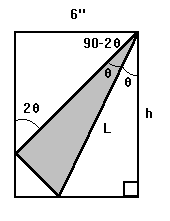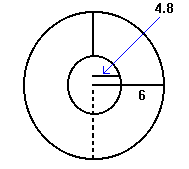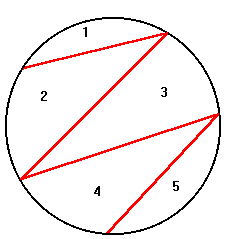Hints:
1) How many kilometers are travelled with 4 tires?
2) How many kilometers does each tire travel out of the distance travelled by 4?
3) Draw a chart to help you.
Distance Travelled #1 #2 #3 #4 #5
1000
2000
3000
4000
5000
Hints:
1) What is the radius of the circle? How would you find it?
2) The pythagorean theorem may help you. c2 = a2 + b2
Hints:
1) Write two equations in terms of the income and expenses of Allie and Basil.
2) It is known that Allie saves 40% of his income. What does this mean?
Income saved = income - expenses
3) So .40 income = income - Allie's expenses
4) Write this equation in terms of B, using the method of substitution.
5) What is the value of income saved for Basil?
Hints:
1) Try to solve the problem by lettering angle DFE = X.
What would angle DEF equal?
2) Solve for the angle ACB.
Hints:
1) Let x be the distance from the foot of the wall to the end of the ladder when the top of the ladder is 7m above the ground. Then what is the distance (in terms of x) from the foot of the wall to the end of the ladder when the bottom of the ladder is moved 1m?
2) Let the length of the ladder equal an arbitrary value (y).
3) Since you know that when the bottom of the ladder is moved 1m and the ladder is lying flat on the floor, what does y equal in terms of x ?
4) You now can make two equations and two unknowns x and y.
(i) one equation is the one you solved for hint 3.
(ii) the other equation is found by using the Pythagrean Theorem.
5) Use substitution or elimination to find the value of x and then y or y then x.
Hints:
1) The volume of the water when the aquarium is on its side and when it is laid horizontal is the same?
2) What is the volume of the water when the aquarium is on its side?
3) Therefore what is the depth of the water when the aquarium is laid horizontal?
Hints:
1) If the record is recorded at 45 r.p.m. and it takes 4 1/2 minutes to play the record at this rate, How many revolutions are required?
2) If you know how many revolutions are required and the rate which he played the record, the second time, then how many minutes did it take him?
Hints:
1) What is the area of the lawn?
2) How much does Todd have to mow?
3) How much does the length and the width reduce by each time around the lawn?
4) Set up a chart:
Time around Area remaining
Start 20*40=800m2
... ...
About how many times does he have to go around?
Hints:
1) Let AB = ED = an arbitrary constant x.
2) Then what does CD = BC =?
3) What is the area in terms of x?
4) The area should be A(x) = x(15-x) + x(15-2x).
5) Factor out a 3 and solve for a perfect square.
6) What is the maximum value of A(x) and where does it occur?
At what value of x does it occur?
Now find the dimension.
Hints:
1) How could you solve for the value of x?
2) How can you solve for the value of the hypoteneuse of a right angle triangle?
3) Find the value of y and z, with the value of x you calculated.
Hints:
1) What do you notice about the angle theta on the diagram and the angle between angle and the edge of the paper when the corner is folds?

2) If we know these two angles are equal what are the angles of the other triangles in the figure?
3) Can you see a relationship between the length of the page and sin(2* theta)?
4) What does sin (2*theta) also equal?
5) What about a relationship between L and sec (theta)?
6) Solve for L!
Hints:
1) How much closer will the dog get, with each jump, to the rabbit?
2) How many jumps will he have to make up for the 45m be lost to the rabbit?
Hints:
1) What does (ac + bd)2 + (ad - bc)2 = ?
2) What does (ac - bd)2 + (ad + bc)2 = ?
3) What are the factors of 481? What are the values of a, b, c, and d, to make this statement true?
4) Historical Note:
This identity was found in Liber abac, written in 1202 by Leonardo Fibonacci. Years later, it formed some initial foundations in modern algebra.
Hints:
1) What is the total length of all the sheets?
2) What is the area of the between the final piece of paper and the cardboard roller?

3) What is the thickness of each sheet?
4) How many times can the paper be wrapped around the cardboard holder? (You know the thickness and the difference in radii).
Hints:
1) How much money in terms of k, does he have after leaving the first casino?
2) Solve for the value of k.
Hints:
1) If angle
3) Try finding the value of each angle.
Hints:
1) In the equation y = 16 +15*sin(Pi*x/60) what variable represents
the height, y or x?
2) What is the period of a sine or a cosine function equal to?
3) When is the maximum height?
What is the x value at this point?
Hints:
1) How many degrees are there between the two hands? (There are 360
degrees in the hour hand moving all the way around the clock).
2) What law can you use to find the distance between the two hands?
3) Can you use the law of cosines or sines to solve this problem?
Hints:
1) NO hints, straight forward.
Hints:
1) How is the distance from the origin to the line y=2x-3 related to the
radius of the circle?
2) Should the radius be greater than or less than this distance?
3) Was Mike right?
Hints:
1) What does the number of digits in the even right side added the
numbers of digits on the odd side equal?
2) What is the difference between the number of odd numbered digits and
even numbered digits?
3) Solve for the number of odd numbered digits, using the previous two
equations.
4) How many houses are on the odd side?
5) How many houses do we need on the even numbered side?
6) What are the missing numbers on the even side? (use trial and error).
Hints:
1) If digit is abc, two equations can be written to satisfy the problem.
What are they?
2) Solve for b by the method of elimination.
3) What equation is left in terms of a and c?
4) Can an inequality be written in terms of a, b and c? a > ?
5) What digit must be c ?
6) What is the final number ?
Hints:
1) Set up systems of equations to describe the information given.
2) Solve these equations by simple substitution.
Hints:
1) Trial and error. draw different circles, trying to maximize or
minimize the number of regions.
EXAMPLE:
5 REGIONS - IS THIS THE MAXIMUM?
Hints:
1) This question is tricky, read the question a few more times before
answering the problem.
Hints:
1) Draw a figure to explain the problem.
2) What is the area of the field?
3) What is the area the sprinkler gets to?
4) What is the percentage that is not sprinkled with water?
Hints:
1) What happens if Bert is innocent?
2) What happens if Bert is guilty?
Hints:
1) What is the area of all the circles?
2) What is the area of the rectangle?
Hints:
1) These shapes represent numbers, and the orientation of
the shapes represents operations.
2) Given the information, try to solve the problem.
b)
1) Try different operations for the @ sign?
2) Trial and error to find the correct answer.
Hints:
1) What 3 numbers between 1 and 6 will give you a sum of 15?
2) How many different arrangements of these sets of numbers can you find?
Hints:
1) Assume that the Chateau family keeps the small cupboard (s) for
daily access to wine and the large cupboard (l) for storage (main supply).
2) What if the family buys n bottles, how many bottles should they
put in s? How many times may they open it? (Remember, they dring 1
bottle a day).
3) How many bottles do they put in n?
4) When l is opened for more wine, how many bottles should be put into s
for daily consumption? And how many is left in l?
5) When l is opened for the eleventh time, how many bottles should be
left for when they open it for the twelfth time?
6) How often do they need to buy wine?
Hints:
1) If he has an area A and he paints 1 square out of nine, how much
of A is left unpainted?
2) When he paints 8 more squares, how much does he leave unpainted?
3) Continue this process until you see a pattern.
Hints:
1) Draw a rectangular solid. From the information can you find the
length, width and height of the rectangular prism?
2) What is the volume?
Hints:
1) What is the equation of the line perpendicular to a1?
(the line pq).
2) What is the x - intercept of this line?
3) What is the slope of a2?
4) What is the y - intercept of the line a2, if you know the x - intercept?
Hints:
a)
1) Simple logarithms.
b)
NIL
Hints:
1) Construct a Table that describes the given information>
Let x be the weight of player #1.
2) What does the weight of player number 2 have to be in order for
the average weight to be increased by 1?
3) What does player number 3's weight have to be?
4) Can you see a pattern?
5) What is the difference between the weight of player # 5 and the weight
of player number 1 when the average increases by 2 kilograms?
Hints:
1) Set up an algebraic expression to describe the problem. If n = the
number of coins in her purse, how much change does she have when 10 cents
is added.
2) Solve the system of equations for n.
3) What are the coins?
Hints:
1) If the value of a unit of money at any given time is "A", then what is
the value of the unit of money one year later? What is its value n years
later?
2) What does the value of the money after n years have to be less than or
equal to?
3) Solve the inequality for n. (The number of years). You need to use
logarithms.
Hints:
1) What number would have to be erased in order to obtain the highest
possible average? If you let n be the last number on the board, what
would the maximum average be in terms of n?
2) In mathematics 1 + 2 + 3 + ...... +n is a geometric sequence defined
as (n+1)n/2. Using this information can you simplify your maximum average?
3) What number would have to be erased to give the smallest average possible?
4) Can you express this average in terms of n?
5) 1+2+.....+n-1 / n-1 = the average
Can you write this as a sequence?
6) Now we know least average < 35 7/17 < greatest average.
7) Solve the inequality for n. What does n have to be greater than or
less than?
8) If x is the number erased and hopefully you found 69 to be the last
number on the board, then what is the value for x?
Hints:
1) In what columns could the number 1000 be?
2) Which column holds the number 1000 and why?
Hints:
1) If BN is extended past N to meet AC, what do you observe? Call this
point E.
2) Can you make any conclusion about the triangles in the diagram? What
is the length of AE?
3) What is the length of MN?
Hints:
1) Let w,x,y,z be amounts paid by Mark, Mike, Lawrence and Joshua,
respectively. How much did Mark pay?
2) Set up systems of equations with the given information!
Hints:
1) What is the minimum height the liquid could be to hide the spoon?
2) What is the minimum volume?
Hints:
1) The time it takes Jerome to get home equals the time it takes Fred to
arrive home. Can you express the time it takes for each of them to
arrive home (in terms of a variable x) ?
2) Solve for x. What is x in your equation?
3) How long should Jerome ride his bike before he starts to walk home?
Hints:
1) What combination of m and n will produce the same star?
2) When n and m share a common factor > 1, the star produced can be
split up into two or more smaller stars.
3) Make a table to count the number of stars formed for each 7, 8, 9, 10,
and 15.
Hints:
NIL -> simple area!
Hints:
1) How must he move his troops when each soldier dies?
2) The general will take the place of a soldier when he has to avoid the
enemy attack.
Hints:
1) Draw a diagram to help you start the problem.
2) How far did the Chevette travel in 1 hour and 20 minutes - the Porche?
(according to x).
3) What theorem can we use to find the value of the variable x ?
Hints:
1) Let x be the number of cats and y be the number of canaries. Can you
set up an algebraic expression to describe the total amount of canaries
and cats?
2) Can you find another equation for when the owner made his mistake?
3) Can you solve this system of equations?
Hints:
1) Try different ages to find out which ages are possible.
Hints:
NONE!!!!
Question #17
Question #18
Question #19
Question #20
Question #21
Question #22
Question #23
Question #24

Question #25
Question #26
Question #27
Question #28
Question #29
Question #30
Question #31
Question #32
Question #33
Question #34
Question #35
Question #36
Player # | Weight | Cumulative
| | Average
------------+------------+---------------
| |
| |
| |
Question #37
Question #38
Question #39
Question #40
Question #41
Question #42
Question #43
Question #44
Question #45
Question #46
Question #47
Question #48
Question #49
Question #50
Question #51